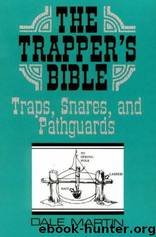The Trapper's Bible: Traps, Snares & Pathguards by Dale Martin

Author:Dale Martin
Language: eng
Format: mobi, epub, pdf
ISBN: 9780873644068
Published: 2010-02-27T08:40:00+00:00
Before I get into a detailed explanation, please study Figures 18 and 19. The drawings will help clarify the word descriptions.
Armed with your general knowledge of snaring from the pest snare and after studying Figures 18 and 19, at least the general scope of the whitetail snare should be readily apparent. Looking at Figure 18, we will go over this snare piece by piece.
Figure 18.
Figure 19. The principle of this whitetail snare is that once tightened, the metal slack stopper will not loosen as a simple loop would do. The slack stopper (shown above) can be made from almost any flat piece of strong metal.
The spring pole is triggered in exactly the same way as in the pest snare. The same type of whittled peg trigger is fine. The purpose of the spring pole itself is slightly different. On a whitetail snare, the spring pole's purpose is to merely snub the snare up tight around the neck when the deer walks through the snare, bumping off the trigger. The spring pole, of course, is not supposed to jerk the deer up in the air, as in a rabbit snare, nor even to hold the deer at the snare site.
The snare itself is made from cable rather than copper wire, for obvious reasons. The diameter of the cable is not terribly important. You can use anywhere from 1/16-inch to 1/4-inch cable, but no smaller or larger than that. You will need a piece 15 to 20 feet long in order to make the lasso and have enough line left for the slack coil and to attach to the drag weight.
The purpose of the short piece of temporary line is for it to break after the spring pole has been triggered and the lasso has been snubbed up on the deer's neck. It should not break instantly, but should be string of such strength that when the deer begins to pull against it, it will eventually break. Kite string is about right. This will leave the deer attached to the drag weight via the cable lasso around its neck.
Note: You may have to use black electrical tape to firmly attach this temporary line to the cable just below the slack stopper.
The purpose of the slack stopper is just as the name implies. Once the snare is snubbed tight around the animal's neck, this device will prevent the cable from backing out as it would if it were merely passing through a loop in the cable. This slack stopper can be made from almost any type of metal. Scrounge around for this, as you may have to buy the cable and clamps.
The cable clamp on the line just down from the slack stopper is to keep the lasso from tightening below about six or eight inches in diameter. This will keep the deer from strangling itself as it pulls along the drag weight. Put this clamp about 12 to 14 inches down the line from the slack stopper. (Note: The three cable clamps
Download
The Trapper's Bible: Traps, Snares & Pathguards by Dale Martin.epub
The Trapper's Bible: Traps, Snares & Pathguards by Dale Martin.pdf
This site does not store any files on its server. We only index and link to content provided by other sites. Please contact the content providers to delete copyright contents if any and email us, we'll remove relevant links or contents immediately.
Backpacker the Complete Guide to Backpacking by Backpacker Magazine(2193)
Capital in the Twenty-First Century by Thomas Piketty(1944)
The Isle of Mull by Terry Marsh(1893)
Predation ID Manual by Kurt Alt(1655)
The Collected Non-Fiction by George Orwell(1571)
Small-Bore Rifles by C. Rodney James(1503)
All Fishermen Are Liars by John Gierach(1443)
Backcountry Bear Basics by Dave Smith(1433)
Creative Confidence by Tom Kelley(1415)
The Art of Throwing by Amante P. Marinas Sr(1354)
50 Famous Firearms You've Got to Own by Rick Hacker(1339)
Archery: The Art of Repetition by Simon Needham(1301)
Blood Mountain by J.T. Warren(1301)
Long Distance Walking in Britain by Damian Hall(1278)
The Scouting Guide to Survival by The Boy Scouts of America(1248)
Backpacker Long Trails by Backpacker Magazine(1246)
The Fair Chase by Philip Dray(1224)
The Real Wolf by Ted B. Lyon & Will N. Graves(1210)
The Ultimate Guide to Home Butchering by Monte Burch(1200)
